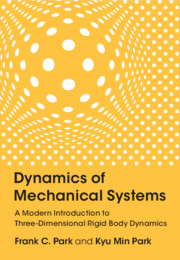
-
Select format
-
- Publisher:
- Cambridge University Press
- Publication date:
- August 2025
- December 2025
- ISBN:
- 9781009609371
- 9781009609333
- Dimensions:
- (244 x 170 mm)
- Weight & Pages:
- 236 Pages
- Dimensions:
- Weight & Pages:
You may already have access via personal or institutional login
Book description
Written by experts in the field, this text provides a modern introduction to three-dimensional dynamics for multibody systems. It covers rotation matrices, the twist-wrench formalism for multibody dynamics and Lagrangian dynamics, an approach that is often overlooked at the undergraduate level. The only prerequisites are differential equations and linear algebra as covered in a first-year engineering mathematics course. The text focuses on obtaining and understanding the equations of motion, featuring a rich set of examples and exercises that are drawn from real-world scenarios. Readers develop a reliable physical intuition that can then be used to apply dynamic analysis software tools, and to develop simplified approximate models. With this foundation, they will be able to confidently use the equations of motion in a variety of applications, ranging from simulation and design to motion planning and control.
Reviews
‘Park and Park have produced a compact and wonderfully accessible introductory treatment of the dynamics of mechanical systems, with a focus on providing tools useful for formulating the equations of motion of a broad range of mechanical systems, from simple toy systems to complex articulated multi-body systems.’
Kevin Lynch - Northwestern University
‘This book fills the gap between highly advanced books on mechanism dynamics and overly simplified textbooks that are often used in undergraduate courses. The book is a concise and nicely written introduction to the Lagrange formalism for 3-dimensional mechanical systems accessible to undergraduate engineering students. It introduces the reader to the geometry and kinematics of rigid bodies and rigid body mechanisms using the compact modern twist-wrench formulation. A central part of the book is the Lagrangian approach to nonlinear dynamics and linearized dynamics. The content is always presented in a way accessible to undergraduate students without compromising rigor of the treatment. The theory is explained via a number of well explained examples. This textbook will be a valuable companion for any engineering student.’
Andreas Müller - Johannes Kepler Universität Linz
Contents
Metrics
Full text views
Full text views help Loading metrics...
Loading metrics...
* Views captured on Cambridge Core between #date#. This data will be updated every 24 hours.
Usage data cannot currently be displayed.
Accessibility standard: WCAG 2.1 A
Why this information is here
This section outlines the accessibility features of this content - including support for screen readers, full keyboard navigation and high-contrast display options. This may not be relevant for you.
Accessibility Information
The PDF of this book complies with version 2.1 of the Web Content Accessibility Guidelines (WCAG), covering newer accessibility requirements and improved user experiences and meets the basic (A) level of WCAG compliance, addressing essential accessibility barriers.
Content Navigation
Table of contents navigation
Allows you to navigate directly to chapters, sections, or non‐text items through a linked table of contents, reducing the need for extensive scrolling.
Index navigation
Provides an interactive index, letting you go straight to where a term or subject appears in the text without manual searching.
Reading Order and Textual Equivalents
Single logical reading order
You will encounter all content (including footnotes, captions, etc.) in a clear, sequential flow, making it easier to follow with assistive tools like screen readers.
Short alternative textual descriptions
You get concise descriptions (for images, charts, or media clips), ensuring you do not miss crucial information when visual or audio elements are not accessible.

